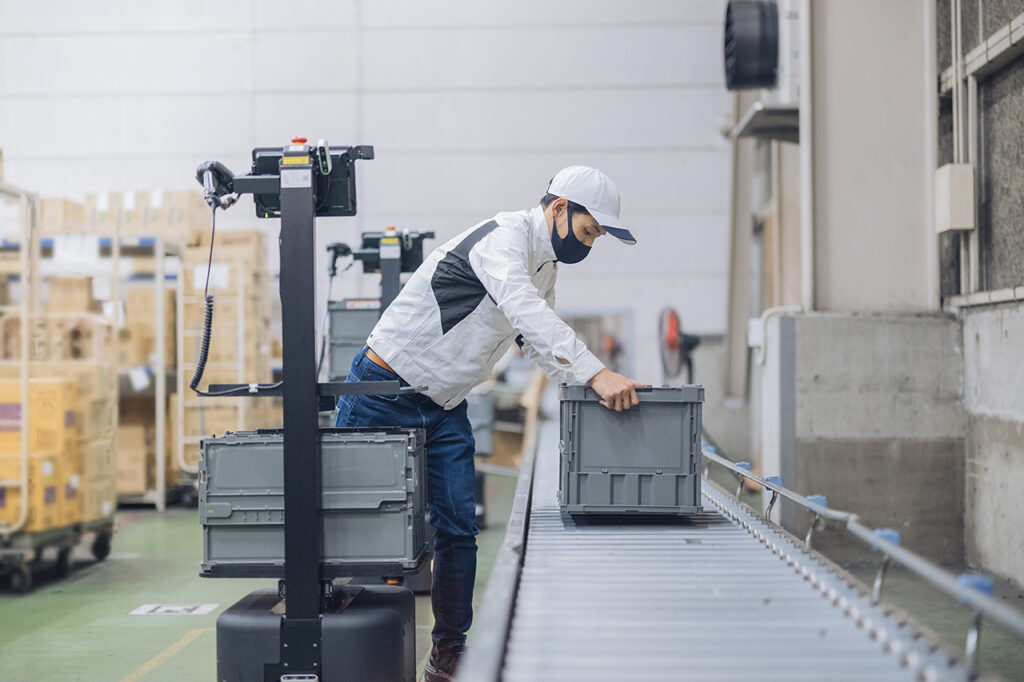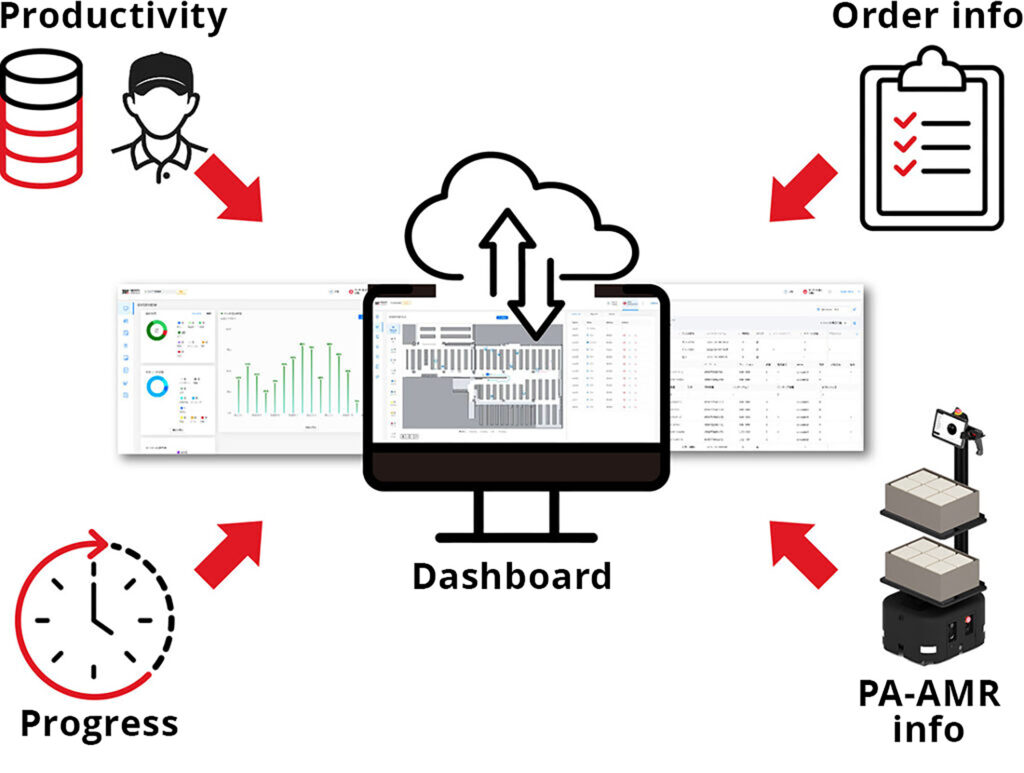
AI-based continuous improvement enhances operational efficiency, reduces errors, and swiftly adapts to changing environments. By analyzing data from our Rapyuta pick assist robots (PA-AMRs), AI identifies patterns, predicts maintenance needs, and suggests optimizations for routes and tasks, leading to improved productivity and cost savings.
AI-driven technology operates within defined boundaries to ensure reliability and safety. These boundaries include adherence to operational protocols, compliance with safety standards, and limits on autonomous decision-making to prevent operational disruptions. AI’s scope is carefully managed to optimize performance while always maintaining control and oversight.
How AI-Based Continuous Improvement Drives Warehouse Innovation

Local and Global Improvements
AI not only optimizes the local operational tasks of individual PA-AMRs but also enhances the global efficiency of the entire distribution center system. It enhances route planning, task allocation, and overall workflow, ensuring that both individual and collective performance are continuously refined and improved.
Order Distribution Optimization
AI algorithms optimize order distribution to enable distribution centers to meet and surpass key performance indicators (KPIs). This process involves analyzing order data, predicting workload distribution, and ensuring that orders are processed in the most efficient manner possible.
Key Parameters Improved by AI

Pick Rates by SKU
Analyzing which items are picked more efficiently, allows for strategic SKU placement and retrieval.
Pick Rates by Associate
Identifying patterns in associate performance helps tailor tasks to individual strengths, enhancing productivity
Pick Rates by Area
Understanding which areas of the warehouse demonstrate higher productivity enables layout optimizations to enhance efficiency
Eliminating Congestion and Traffic
AI-based traffic control systems can significantly reduce congestion and drastically improve traffic flow within facilities, enhancing throughput and operational efficiency. This leads to reduced costs and higher customer satisfaction. Examples include:
Dynamic Routing
AI optimizes traffic control by dynamically managing PA-AMR movements through real-time route adjustments and task prioritization, ensuring smooth traffic flow within the DC. It also can optimize pick paths and routing for warehouse workers and can determine the most efficient routes for completing tasks and minimizing traffic bottlenecks.

Navigating Obstacles
The implementation of AI allows PA-AMRs to follow predetermined paths and tracks, restricting their movement to avoid collision with warehouse obstacles. Equipped with multiple sensors and mechanisms, AI systems promptly identify and communicate obstacles, ensuring PA-AMRs navigate safely. This includes object detection and recognition, immediate adjustments to avoid static and dynamic obstacles.

Working with Additional AMRs
One of the greatest benefits of using AI in the warehouse is that PA-AMRs can work with multiple AMRs. AI provides a seamless interaction between PA-AMRs and other AMRs to coordinate tasks and movements to optimize workflow and space utilization without interference. Since associates can work with multiple AMRs concurrently, idle time between picks is eliminated.
To get a bird’s eye view of multiple AMRs in action, click here >>.

Working with Labor
One of the greatest benefits of using AI in the warehouse is that it enhances collaboration between human workers and technology. AI provides seamless interaction between human associates and automated systems to coordinate tasks and movements, optimizing workflow and space utilization without interference. Since associates can efficiently manage and interact with automated systems, idle time between tasks is minimized, leading to increased productivity and job satisfaction.

Automated Sortation and Put Walls
AI harmoniously integrates PA-AMRs with automated sortation systems and put walls. Put walls—where items are temporarily stored after being picked but before being packed—and automated sorting systems—a type of material handling equipment that automates the process of sorting and routing items—can be enhanced through the use of AI since the sorting and allocation process will be more accurate and efficient.

Other Opportunities for AI
For warehouses looking for additional reasons to employ AI, here are other areas that will benefit:

Dashboard Analysis
- AI-driven dashboards offer comprehensive analytics, highlighting efficiencies and areas for improvement and guiding strategic decisions.
Big Data Analysis
- AI processes vast datasets, uncovering patterns and insights that inform operational adjustments and strategic planning.
Algorithm Visibility Variables for DC Improvements
- Changes to Order Distribution Algorithm: AI suggests modifications to optimize order handling
- Seasonality Changes and SKU Mix Impact: AI adapts strategies based on seasonal demand shifts
- More Robots = Improved Throughput: AI assesses and recommends scaling robot deployment for enhanced productivity
Error Detection and CI
- Missed Shipment Root Cause Analysis and Suggestions: AI identifies the causes of missed shipments and proposes corrective actions
- Inaccurate Pick Analysis: AI analyzes picking errors, offering solutions to enhance accuracy
- Throughput Reduction Analysis: AI identifies factors reducing throughput, suggesting improvements
By taking over the repetitive tasks that often lead to injury or overuse, AI-empowered PA-AMRs significantly enhance workplace safety, reduce labor costs and operational inefficiencies, and ensure substantial cost savings. Additionally, the environmental footprint of distribution can be lessened, through more efficient resource use and reduction in waste.
To learn more about our PA-AMRs and how AI-based continuous improvement drives warehouse innovation, contact us today!



